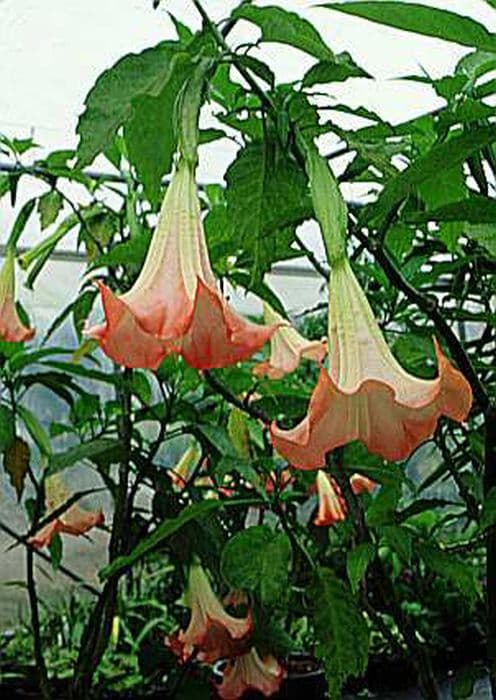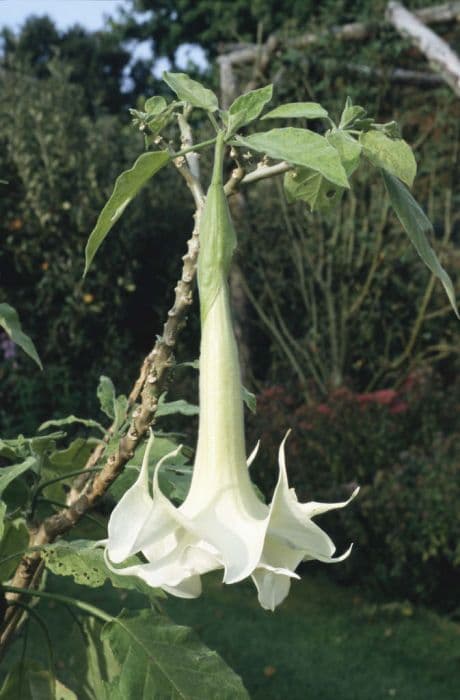Million Bells Calibrachoa Aloha Classic Gold (Aloha Classic Series)
![calibrachoa [Aloha Classic Gold]](/_next/image?url=https%3A%2F%2Fplants-admin.emdemapps.com%2Fimages%2Fplants%2F%2Fimages%2F604b6284c573e.png&w=3840&q=75)
ABOUT
The Calibrachoa Aloha Classic Gold is a striking plant well-loved for its ornamental qualities. This variety showcases a profusion of vibrant, golden-yellow flowers that exude a sunny and warm appeal. The blooms are trumpet-shaped, with a slightly flared limb, and are small to medium-sized. They closely resemble miniature petunias, which is a visual hallmark of the Calibrachoa genus. As part of the Aloha Classic Series, the Aloha Classic Gold is characterized by its lush, trailing foliage, made up of small, oblong to ovate leaves that provide a dense and verdant backdrop to the eye-catching flowers. The leaves are often a deep green, which contrasts strikingly with the bright yellow of the blossoms. Since this plant tends to produce a cascade of color, it is commonly used in hanging baskets and containers where its floriferous display can truly be appreciated. The Calibrachoa Aloha Classic Gold is notable for its continuous bloom throughout the growing season, making it a popular choice for gardeners looking to add long-lasting vibrancy to their outdoor spaces.
About this plant
 Names
NamesFamily
Solanaceae
Synonyms
Million Bells, Mini Petunia
Common names
Calibrachoa Aloha Classic Gold.
 Toxicity
ToxicityTo humans
Calibrachoas, commonly known as million bells, typically are not considered toxic to humans. However, ingesting any part of the plant is not advised as they are not edible. If large quantities are consumed, it might cause mild gastrointestinal discomfort, including nausea, vomiting, or diarrhea. Always be cautious with plants that are not designated as food crops, and keep them out of reach of children who might inadvertently ingest them.
To pets
Million bells, the common name for Calibrachoa, are generally not toxic to pets. There are no significant reports of poisoning in pets such as dogs and cats from consuming this plant. Nonetheless, it's always a good practice to prevent pets from eating ornamental plants as they can sometimes cause mild gastrointestinal upset or an allergic reaction. If your pet ingests any part of the million bells plant and shows any symptoms of distress, consulting a veterinarian is advisable.
 Characteristics
CharacteristicsLife cycle
Annuals
Foliage type
Evergreen
Color of leaves
Green
Flower color
Gold
Height
1 foot [30 cm]
Spread
2 feet [60 cm]
Plant type
Herb
Hardiness zones
9
Native area
South America
Benefits
 General Benefits
General Benefits- Robust Growth: Calibrachoa, also known as million bells, has vigorous growth that quickly fills garden spaces with lush foliage and flowers.
- Continuous Blooming: It blooms prolifically from spring until frost, providing long-lasting color in garden beds or containers.
- Drought Tolerance: Once established, it is fairly drought-resistant, making it an ideal choice for gardens in drier climates.
- Low Maintenance: Million bells require minimal care, making them suitable for gardeners of all levels, from beginner to expert.
- Attracts Pollinators: The flowers attract beneficial insects such as bees and butterflies, helping pollinate other plants in the garden.
- Versatile Use: It can be planted in hanging baskets, window boxes, or as a ground cover, adding versatility to garden design.
- Colorful Display: Offers bright golden-yellow flowers that can add a vibrant touch to any landscape or container garden.
- Compact Size: Its mounded, trailing habit makes it an excellent choice for small spaces and for use as a border plant.
- Heat Tolerance: It is capable of withstanding hot summer temperatures, maintaining its bloom and foliage quality.
 Medical Properties
Medical PropertiesThis plant is not used for medical purposes.
 Air-purifying Qualities
Air-purifying QualitiesThis plant is not specifically known for air purifying qualities.
 Other Uses
Other Uses- Photographic Subject: The vibrant gold petals of Calibrachoa can be used as a stunning subject in macro photography to create visually engaging art.
- Education: Calibrachoa can serve as a specimen in educational settings, teaching students about plant biology, hybridization, and pollination methods.
- Color Dyes: The intense pigments of the flowers might be used in the craft of natural dyeing for fabrics or paper, although calibrachoas are not typically known for this purpose.
- Theme Gardens: These plants can be used to create a 'gold' themed garden or area, adding vibrant color contrast when paired with darker foliage or flowers.
- Fairy Gardens: Their small size and bright flowers make calibrachoa suitable for use in creating whimsical fairy gardens.
- Art Inspiration: Artists may use the flower as inspiration for paintings, drawings, or textile designs, capturing its form and color.
- Culinary Decoration: Though not edible, the flowers can be used as temporary ornamental additions to plates or tables for garden parties before being removed.
- Screening: When grown in mass or as a living wall, calibrachoa can provide visual screening for unsightly areas in a garden or yard.
- Seasonal Festivities: The golden hue fits well with autumn decorations, and plants can be integrated into seasonal displays.
- Container Combinations: Calibrachoa can be mixed with other container-friendly plants to create dynamic and multi-textured displays.
Interesting Facts
 Feng Shui
Feng ShuiThe Calibrachoa is not used in Feng Shui practice.
 Zodiac Sign Compitability
Zodiac Sign CompitabilityThe Calibrachoa is not used in astrology practice.
 Plant Symbolism
Plant Symbolism- Prosperity: The vibrant golden petals of Calibrachoa can represent wealth and prosperity, possibly due to their lush and abundant blooms which resemble coins.
- Optimism: The bright, sunny hue of this plant's flowers often symbolizes positivity and a cheerful outlook on life.
- Admiration: Calibrachoas, with their attractive and eye-catching appearance, can symbolize admiration and the joy that beauty brings into our lives.
- Celebration: The plant's 'Aloha' series name and its lively golden color can evoke feelings of festivity and celebration, much like a warm, vibrant party atmosphere.
 Water
WaterMillion Bells should be watered deeply, allowing the top inch of soil to dry out between waterings. In general, this might mean watering every few days during hot, dry periods, reducing to once a week in cooler weather. The amount of water needed will vary based on climate, but aim for about 16-24 ounces every time you water to ensure the soil is moistened thoroughly. Avoid overwatering which can lead to root rot, and ensure adequate drainage to prevent standing water.
 Light
LightMillion Bells thrives in full sun, with at least 6 to 8 hours of direct sunlight daily. Place them in a spot where they can receive plenty of daylight to encourage abundant blooms. They can tolerate some partial shade, especially in hot climates, but too much shade can reduce flowering and lead to leggy growth.
 Temperature
TemperatureMillion Bells prefer a temperature range of 55 to 65 degrees Fahrenheit at night and 65 to 75 degrees Fahrenheit during the day. They can tolerate temperatures down to 35 degrees Fahrenheit for short periods, but frost can damage the plant. Consistently warm conditions are ideal for growth and flowering.
 Pruning
PruningPrune Million Bells to encourage bushier growth and more blooms. Trim back the plant every few weeks during the active growing season, cutting back up to one-third of the length of the stems. The best time for pruning is in late spring or early summer before the plant has set buds for the season.
 Cleaning
CleaningAs needed
 Soil
SoilThe Million Bells requires well-draining, nutrient-rich potting mix with peat moss or coco coir, perlite, and compost. Aim for a slightly acidic to neutral pH of 5.6 to 6.5.
 Repotting
RepottingMillion Bells should typically be repotted every 1 to 2 years or when you notice it has outgrown its container or the soil has degraded.
 Humidity & Misting
Humidity & MistingMillion Bells thrives best in moderate humidity levels but is quite adaptable to various ambient moisture conditions.
 Suitable locations
Suitable locationsIndoor
Place it near a sunny window; keep soil moist but not wet.
Outdoor
In full to partial sun, water regularly but ensure good drainage.
Hardiness zone
9-11 USDA
 Life cycle
Life cycleThe life of Calibrachoa, commonly known as Million Bells, begins with a seed which, when sowed, germinates within a week or two in warm conditions. Once the seedlings emerge and develop true leaves, they enter the vegetative stage, during which they grow rapidly, developing a bushy structure with numerous branches. As the plant matures, usually within a few weeks, it enters the flowering stage, producing a plethora of small, petunia-like flowers that can be a golden yellow color, especially in the Aloha Classic Gold cultivar. These flowers attract pollinators and, if pollinated, can develop into tiny, non-descript fruit containing seeds for the next generation. The plant will continue to bloom and grow throughout the spring and summer, often until the first frost. Typically grown as an annual, Calibrachoa reaches the end of its life cycle within a year, but its seeds can perpetuate the species when the next suitable growing season arrives.
 Propogation
PropogationPropogation time
Spring-Early Summer
Propogation: The Calibrachoa, commonly referred to as mini petunia, is effectively propagated through cuttings rather than seed to maintain the specific characteristics of the Aloha Classic Gold variety. The optimal time for taking cuttings is in late spring or early summer. To propagate, a healthy, non-flowering stem is selected and cut to a length of 4 to 6 inches (about 10 to 15 centimeters). The lower leaves are removed, and the cut end is dipped in a rooting hormone to encourage root development. The cutting is then inserted into a moist potting mix, ensuring that the nodes where the leaves were removed are below the surface. The pot is placed in a warm, well-lit area but out of direct sunlight, and the medium is kept consistently moist until roots have established, which typically takes a few weeks. It is critical to maintain high humidity around the cutting during this period, which can be achieved by covering the pot with a plastic bag or using a propagation dome.


![Calibrachoa [Aloha Classic Blue Sky]](/_next/image?url=https%3A%2F%2Fplants-admin.emdemapps.com%2Fimages%2Fplants%2F%2Fimages%2F604b636c3778b.png&w=640&q=75)
![Calibrachoa [Aloha Classic Tiki Soft Pink]](/_next/image?url=https%3A%2F%2Fplants-admin.emdemapps.com%2Fimages%2Fplants%2F%2Fimages%2F604b548e0a5ef.png&w=640&q=75)
![Calibrachoa [Cabaret Deep Yellow]](/_next/image?url=https%3A%2F%2Fplants-admin.emdemapps.com%2Fimages%2Fplants%2F%2Fimages%2F604b5f20ca3ef.png&w=640&q=75)
![Calibrachoa [Calibasket Radiant Orange]](/_next/image?url=https%3A%2F%2Fplants-admin.emdemapps.com%2Fimages%2Fplants%2F%2Fimages%2F604b536d43cb2.png&w=640&q=75)
![Calibrachoa [Caloha Classic Blue Velvet]](/_next/image?url=https%3A%2F%2Fplants-admin.emdemapps.com%2Fimages%2Fplants%2F%2Fimages%2F604b604884a75.png&w=640&q=75)
![Calibrachoa [Caloha Classic Honey White]](/_next/image?url=https%3A%2F%2Fplants-admin.emdemapps.com%2Fimages%2Fplants%2F%2Fimages%2F604b5f56e0beb.png&w=640&q=75)
![Calibrachoa [Caloha Classic Yellow Chocolate Ring]](/_next/image?url=https%3A%2F%2Fplants-admin.emdemapps.com%2Fimages%2Fplants%2F%2Fimages%2F604b538aede95.png&w=640&q=75)
![Calibrachoa [Caloha Grand Purple]](/_next/image?url=https%3A%2F%2Fplants-admin.emdemapps.com%2Fimages%2Fplants%2F%2Fimages%2F604b6192993d2.png&w=640&q=75)